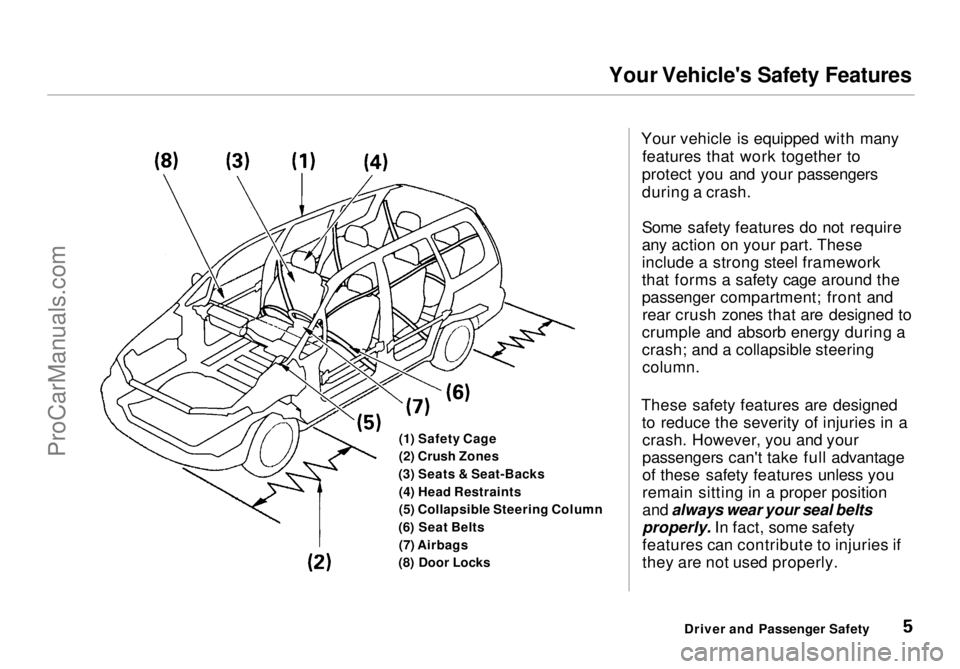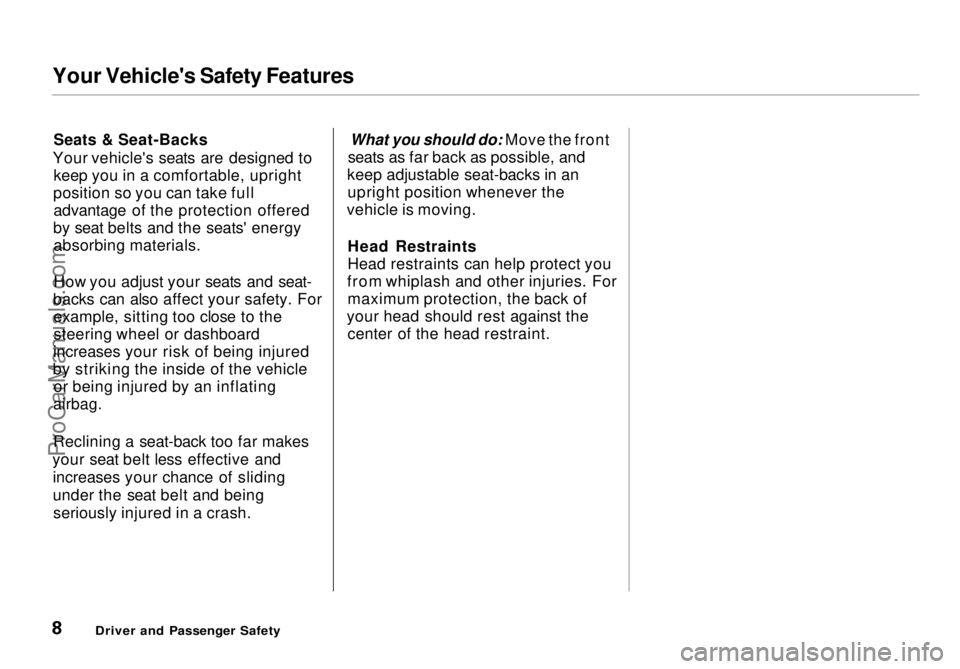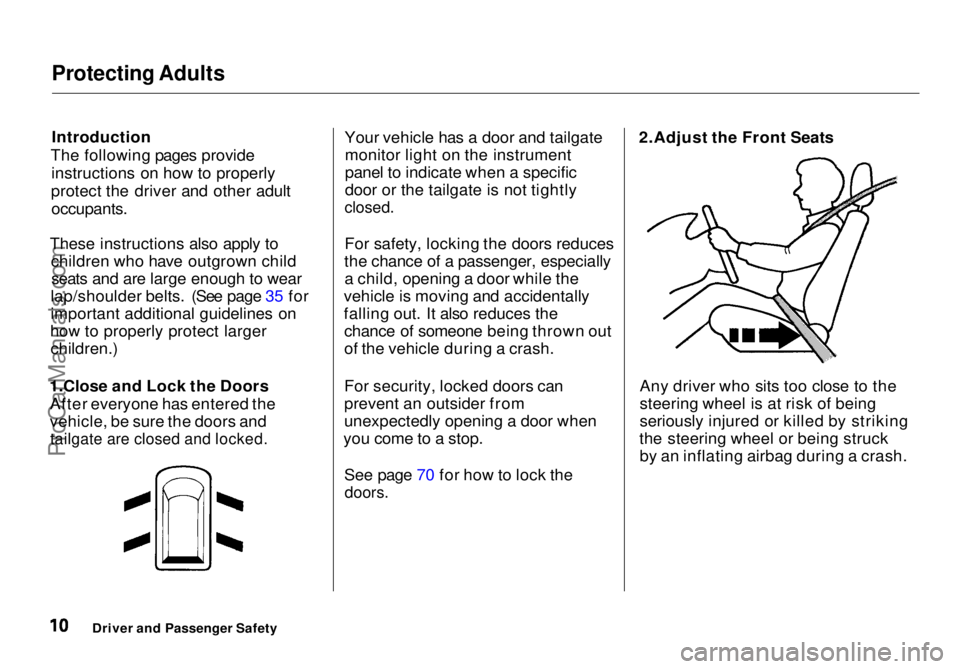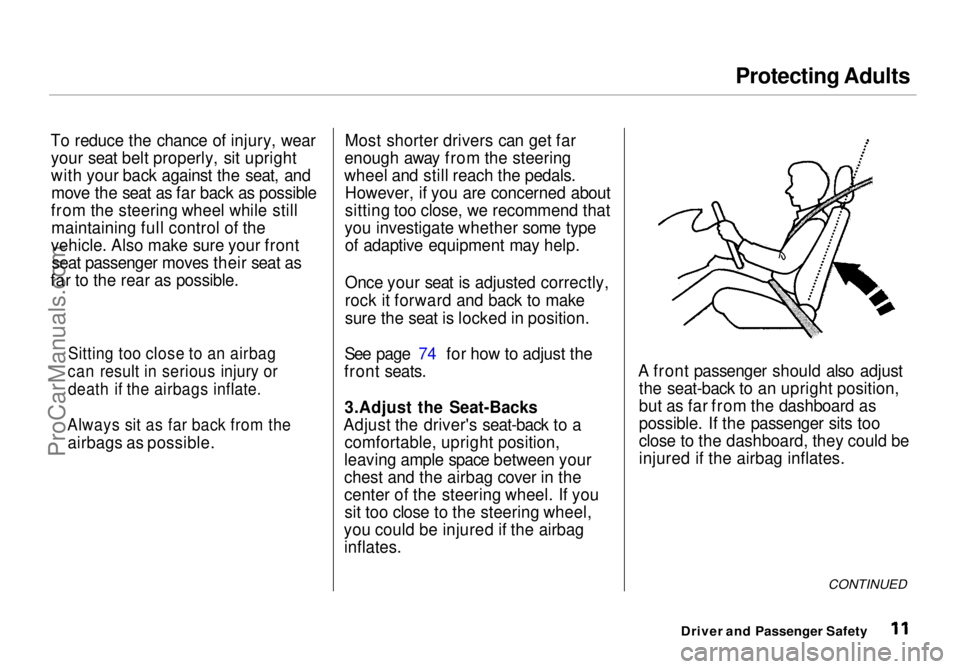1998 HONDA ODYSSEY steering
[x] Cancel search: steeringPage 1 of 272

1998 Odyssey Online Reference Owner's Manual
Use these links (and links throughout this manual) to navigate through\
this reference.
For a printed owner's manual, click on authorized manuals or go to www.h\
elminc.com.
Contents
Owner's Identification Form
Introduction ........................................................................\
............................................................... i
A Few Words About Safety........................................................................\
....................................... ii
Driver and Passenger Safety ........................................................................\
.................................... 3
Proper use and care of your vehicle's seat belts, and Supplemental Restr\
aint System.
Instruments and Control s........................................................................\
........................................ 49
Instrument panel indicator and gauge, and how to use dashboard and steering colu\
mn controls.
Comfort and Convenience Features ........................................................................\
...................... 93
How to operate the climate control system, the audio system, and other c\
onvenience features.
Before Driving........................................................................\
..........................................................127
What gasoline to use, how to break -in your new vehicle, and how to load luggage and other cargo.
Driving ........................................................................\
......................................................................139
The proper way to start the engine, shift the transmission, and park, pl\
us towing a trailer.
Maintenance........................................................................\
.............................................................159
The Maintenance Schedule shows you when you need to take you r vehicle to the dealer.
Appearance Car e........................................................................\
..................................................... .213
Tips on cleaning and protecting your vehicle. Things to look for if your\
vehicle ever needs body repairs.
Taking Care of the Unexpecte d........................................................................\
..............................221
This section covers several problems motorists sometimes experience, an d how to handle them.
Technical Informatio n........................................................................\
.............................................245
ID numbers, dimensions, capacities, and technical information.
Warranty and Customer Relations (U.S. and Canada)................................................................259
A summary of the warranties covering your new Acura, and how to contact \
us.
Authorized Manu als (U.S. only)........................................................................\
..............................265
How to order manuals and other technical literature.
Index........................................................................\
.............................................................................. I
Service Information Summary
A summary of information you need when you pull up to the fuel pump.
ProCarManuals.com
Page 4 of 272

Driver and Passenger Safety
This section gives you important information about how to protect
yourself and your passengers. It
shows you how to use seat belts
properly. It explains your Supple-
mental Restraint System. And it tells
you how to properly restrain infants
and children in your vehicle.
Important Safety Precautions .......... 4
Your Vehicle's Safety Features........ 5
Seat Belts........................................ 6
Airbags............................................ 7
Seats & Seat-Backs........................ 8
Head Restraints............................. 8
Door Locks..................................... 9
Pre-Drive Safety Checklist........... 9
Protecting Adults............................. 10 1. Close and Lock the Doors...... 10
2. Adjust the Front Seats............ 10
3. Adjust the Seat-Backs............. 11
4. Adjust the Head Restraints.... 12
5. Fasten and Position the Seat
Belts...................................... 13
6. Adjust the Steering Wheel..... 16
7. Maintain a Proper Sitting
Position................................. 16
Advice for Pregnant Women...... 17
Additional Safety Precautions.... 17
Protecting Children......................... 19
All Children Must Be Restrained................................ 19
Children Should Sit in the Back
Seat............................................ 20
The Passenger's Airbag Poses Serious Risks to Children....... 20
If You Must Drive with Several Children.................................... 21 If a Child Requires Close
Attention................................... 22
Additional Safety Precautions.... 22
General Guidelines for Using
Child Seats................................ 23
Protecting Infants........................ 27
Protecting Small Children.......... 31
Protecting Larger Children........ 35 Using Child Seats with Tethers...................................... 38
Additional Information About Your Seat Belts.................................. 41
Seat Belt System Components... 41
Lap/Shoulder Belt....................... 41
Lap Belt......................................... 42
Seat Belt Maintenance................ 42
Additional Information About Your
SRS........................................... 44
SRS Components......................... 44
How Your Airbags Work............ 44
How Your SRS Indicator Light
Works........................................ 45
SRS Service................................... 46
Additional Safety Precautions.... 46
Carbon Monoxide Hazard.............. 47
Safety Labels.................................... 48
Driver and Passenger SafetyProCarManuals.comMain Menu s t
Page 6 of 272

Your Vehicle's Safety Features
(1) Safety Cage
(2) Crush Zones
(3) Seats & Seat-Backs (4) Head Restraints
(5) Collapsible Steering Column
(6) Seat Belts (7) Airbags
(8) Door Locks Your vehicle is equipped with many
features that work together to
protect you and your passengers
during a crash.
Some safety features do not require
any action on your part. These
include a strong steel framework
that forms a safety cage around the
passenger compartment; front and rear crush zones that are designed to
crumple and absorb energy during a
crash; and a collapsible steering
column.
These safety features are designed to reduce the severity of injuries in acrash. However, you and your
passengers can't take full advantage
of these safety features unless you
remain sitting in a proper position
and always wear your seal belts
properly. In fact, some safety
features can contribute to injuries if
they are not used properly.
Driver and Passenger SafetyProCarManuals.comMain Menu Table of Contents s t
Page 8 of 272

Your Vehicle's Safety Features
Airbags
Your vehicle has a Supplemental Restraint System (SRS) with frontal
airbags to help protect the driver and
a front seat passenger.
This system also includesan indicator light on the
instrument panel to alert you to a
possible problem with the system. Following are the most important
things you need to know about your
airbags:
Airbags do not replace seat belts.
They supplement seat belts by providing extra protection for the
heads and chests of front seat
occupants.
Airbags offer no protection in side impacts, rear impacts, rollovers,or minor or moderate collisions.
Airbags are designed to deploy only during a severe frontal
collision (such as a 25 mph [40
km/h] crash into a parked vehicle of similar size and weight). Airbags can pose serious hazards.
To do their job, airbags must inflate with tremendous force and
speed. So while airbags save lives,
they can cause serious injuries to
adults and larger children who are
not wearing seat belts, are not wearing them properly, are sitting
too close to the airbag, or are notsitting in a proper position. Infants
and small children are at an even
greater risk of injury or death.
What you should do: Always wear
your seat belt properly and sit upright and as far back as possible
from the steering wheel or dashboard.
Driver and Passenger Safety
SRS
ProCarManuals.comMain Menu Table of Contents s t
Page 9 of 272

Your Vehicle's Safety Features
Seats & Seat-Backs
Your vehicle's seats are designed to keep you in a comfortable, upright
position so you can take full advantage of the protection offered
by seat belts and the seats' energy absorbing materials.
How you adjust your seats and seat-
backs can also affect your safety. For example, sitting too close to the
steering wheel or dashboard
increases your risk of being injured
by striking the inside of the vehicle or being injured by an inflating
airbag.
Reclining a seat-back too far makes
your seat belt less effective and increases your chance of sliding
under the seat belt and beingseriously injured in a crash.
What you should do: Move the front
seats as far back as possible, and
keep adjustable seat-backs in an upright position whenever the
vehicle is moving.
Head Restraints
Head restraints can help protect you
from whiplash and other injuries. For maximum protection, the back of
your head should rest against the center of the head restraint.
Driver and Passenger SafetyProCarManuals.comMain Menu Table of Contents s t
Page 10 of 272

Your Vehicle's Safety Features
Door Locks
Keeping your doors locked reduces
the chance of being thrown out of
the vehicle during a crash. It also
helps prevent occupants from accidentally opening a door and
falling out, and outsiders from unexpectedly opening your doors.
Pre-Drive Safety Checklist
To make sure you and your passengers get the maximum
protection from your vehicle's safety
features, check the following each
time before you drive away: All adults, and children who have
outgrown child safety seats, are
wearing their seat belts and
wearing them properly (see page
13).
Any infant or small child is
properly restrained in a child seat
in a back seat (see page 19 ). Front seat occupants are sitting as
far back as possible from the steering wheel and dashboard (see page 10). Seat-backs are upright (see page
11).
Head restraints are properly
adjusted (see page 12 ). All doors and the tailgate are
closed and locked (see page 10). All cargo is properly stored or
secured (see page 136).
The rest of this section gives more detailed information about how you
can maximize your safety.
Remember, however, that no safety system can prevent all injuries ordeaths that can occur in severe
crashes, even when seat belts are
properly worn and the airbags deploy.
Driver and Passenger SafetyProCarManuals.comMain Menu Table of Contents s t
Page 11 of 272

Protecting Adults
Introduction
The following pages provide instructions on how to properly
protect the driver and other adult
occupants.
These instructions also apply to children who have outgrown childseats and are large enough to wear
lap/shoulder belts. (See page 35 for
important additional guidelines on
how to properly protect larger children.)
1.Close and Lock the Doors After everyone has entered the
vehicle, be sure the doors and
tailgate are closed and locked.
Your vehicle has a door and tailgate
monitor light on the instrument
panel to indicate when a specific
door or the tailgate is not tightly
closed.
For safety, locking the doors reduces
the chance of a passenger, especially a child, opening a door while the
vehicle is moving and accidentally
falling out. It also reduces the chance of someone being thrown out
of the vehicle during a crash.
For security, locked doors can
prevent an outsider from
unexpectedly opening a door when
you come to a stop.
See page 70 for how to lock the
doors.
2.Adjust the Front Seats
Any driver who sits too close to thesteering wheel is at risk of being
seriously injured or killed by striking
the steering wheel or being struck by an inflating airbag during a crash.
Driver and Passenger SafetyProCarManuals.comMain Menu Table of Contents s t
Page 12 of 272

Protecting Adults
To reduce the chance of injury, wear your seat belt properly, sit upright
with your back against the seat, andmove the seat as far back as possible
from the steering wheel while still maintaining full control of the
vehicle. Also make sure your front seat passenger moves their seat as
far to the rear as possible. Most shorter drivers can get far
enough away from the steering
wheel and still reach the pedals. However, if you are concerned about
sitting too close, we recommend that
you investigate whether some type of adaptive equipment may help.
Once your seat is adjusted correctly,
rock it forward and back to make
sure the seat is locked in position.
See page 74 for how to adjust the
front seats.
3.Adjust the Seat-Backs
Adjust the driver's seat-back to a comfortable, upright position,
leaving ample space between your
chest and the airbag cover in the
center of the steering wheel. If you sit too close to the steering wheel,
you could be injured if the airbag inflates. A front passenger should also adjust
the seat-back to an upright position,
but as far from the dashboard as
possible. If the passenger sits too
close to the dashboard, they could be
injured if the airbag inflates.
CONTINUED
Driver and Passenger Safety
Sitting too close to an airbag
can result in serious injury or
death if the airbags inflate.
Always sit as far back from the
airbags as possible.ProCarManuals.comMain Menu Table of Contents s t